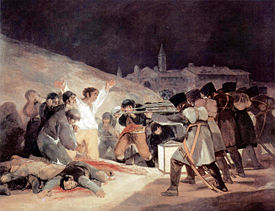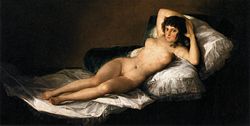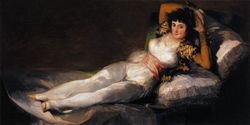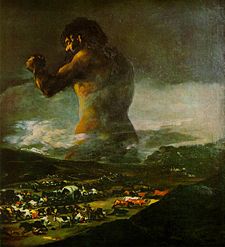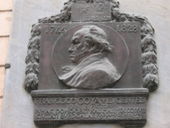Francisco Goya
2008/9 Schools Wikipedia Selection. Related subjects: Artists
| Francisco Goya | |
 Goya's self-portrait. |
|
| Birth name | Francisco José de Goya y Lucientes |
| Born | March 30, 1746 Fuendetodos |
| Died | April 16, 1828 (aged 82) Bordeaux |
| Nationality | Spanish |
| Field | Painting, Printmaking |
| Works | La maja desnuda, ca. 1800 La maja vestida, ca. 1803 The Second of May 1808, 1814 |
Francisco José de Goya y Lucientes ( March 30, 1746 – April 16, 1828) was an Aragonese Spanish painter and printmaker. Goya was a court painter to the Spanish Crown and a chronicler of history. He has been regarded both as the last of the Old Masters and as the first of the moderns. The subversive and subjective element in his art, as well as his bold handling of paint, provided a model for the work of later generations of artists, notably Manet and Picasso.
Biography
Youth
Goya was born in Fuendetodos, Spain, in the kingdom of Aragón in 1746 to José Benito de Goya y Franque and Gracia de Lucientes y Salvador. He spent his childhood in Fuendetodos, where his family lived in a house bearing the family crest of his mother. His father earned his living as a gilder. About 1749, the family bought a house in the city of Zaragoza and some years later moved into it. Goya attended school at Escuelas Pias, where he formed a close friendship with Martin Zapater, and their correspondence over the years became valuable material for biographies of Goya. At age 14, he entered apprenticeship with the painter José Luján.
He later moved to Madrid where he studied with Anton Raphael Mengs, a painter who was popular with Spanish royalty. He clashed with his master, and his examinations were unsatisfactory. Goya submitted entries for the Royal Academy of Fine Art in 1763 and 1766, but was denied entrance.
He then journeyed to Rome, where in 1771 he won second prize in a painting competition organized by the City of Parma. Later that year, he returned to Zaragoza and painted a part of the cupola of the Basilica of the Pillar, frescoes of the oratory of the cloisters of Aula Dei, and the frescoes of the Sobradiel Palace. He studied with Francisco Bayeu y Subías and his painting began to show signs of the delicate tonalities for which he became famous.
Maturity and success
Goya married Bayeu's sister Josefa in 1774. His marriage to Josefa (he nicknamed her "Pepa"), and Francisco Bayeu's membership of the Royal Academy of Fine Art (from the year 1765) helped him to procure work with the Royal Tapestry Workshop. There, over the course of five years, he designed some 42 patterns, many of which were used to decorate (and insulate) the bare stone walls of El Escorial and the Palacio Real de El Pardo, the newly built residences of the Spanish monarchs. This brought his artistic talents to the attention of the Spanish monarchs who later would give him access to the royal court. He also painted a canvas for the altar of the Church of San Francisco El Grande, which led to his appointment as a member of the Royal Academy of Fine Art.
In 1783, the Count of Floridablanca, a favorite of King Carlos III, commissioned him to paint his portrait. He also became friends with Crown Prince Don Luis, and lived in his house. His circle of patrons grew to include the Duke and Duchess of Osuna, whom he painted, the King and other notable people of the kingdom.
After the death of Charles III in 1788 and revolution in France in 1789, during the reign of Charles IV, Goya reached his peak of popularity with royalty.
Caprichos
After contracting a high fever in 1792 Goya was left deaf, and he became withdrawn and introspective. During the five years he spent recuperating, he read a great deal about the French Revolution and its philosophy. The bitter series of aquatinted etchings that resulted were published in 1799 under the title Caprichos. The dark visions depicted in these prints are partly explained by his caption, "The sleep of reason produces monsters". Yet these are not solely bleak in nature and demonstrate the artist's sharp satirical wit, particularly evident in etchings such as Hunting for Teeth. Additionally, one can discern a thread of the macabre running through Goya's work, even in his earlier tapestry cartoons.
Painter of royalty
In 1786 Goya was appointed painter to Charles III, and in 1789 was made court painter to Charles IV. In 1799 he was appointed First Court Painter with a salary of 50,000 reales and 500 ducats for a coach. He worked on the cupola of the Hermitage of San Antonio de la Florida; he painted the King and the Queen, royal family pictures, portraits of the Prince of the Peace and many other nobles. His portraits are notable for their disinclination to flatter, and in the case of The Family of Charles IV, the lack of visual diplomacy is remarkable.
Goya received orders from many friends within the Spanish nobility. Among those from whom he procured portrait commissions were Pedro de Álcantara Téllez-Girón, 9th Duke of Osuna and his wife María Josefa de la Soledad, 9th Duchess of Osuna, María del Pilar Teresa Cayetana de Silva Alvarez de Toledo, 13th Duchess of Alba (universally known simply as the "Duchess of Alba"), and her husband José Alvarez de Toledo y Gonzaga, 13th Duke of Alba, and María Ana de Pontejos y Sandoval, Marchioness of Pontejos.
Later years
As French forces invaded Spain during the Peninsular War (1808–1814), the new Spanish court received him as had its predecessors.
When Josefa died in 1812, Goya was painting The Charge of the Mamelukes and The Third of May 1808, and preparing the series of prints known as The Disasters of War (Los desastres de la guerra).
King Ferdinand VII came back to Spain but relations with Goya were not cordial. In 1814 Goya was living with his housekeeper Doña Leocadia and her illegitimate daughter, Rosario Weiss; the young woman studied painting with Goya, who may have been her father. He continued to work incessantly on portraits, pictures of Santa Justa and Santa Rufina, lithographs, pictures of tauromachy, and more. With the idea of isolating himself, he bought a house near Manzanares, which was known as the Quinta del Sordo (roughly, "House of the Deaf Man", titled after its previous owner and not Goya himself). There he made the Black Paintings.
Unsettled and discontented, he left Spain in May 1824 for Bordeaux and Paris. He settled in Bordeaux. He returned to Spain in 1826 after another period of ill health. Despite a warm welcome, he returned to Bordeaux where he died in 1828 at the age of 82.
Works
Goya painted the Spanish royal family, including Charles IV of Spain and Ferdinand VII. His themes range from merry festivals for tapestry, draft cartoons, to scenes of war and corpses. This evolution reflects the darkening of his temper. Modern physicians suspect that the lead in his pigments poisoned him and caused his deafness since 1792. Near the end of his life, he became reclusive and produced frightening and obscure paintings of insanity, madness, and fantasy. The style of these Black Paintings prefigure the expressionist movement. He often painted himself into the foreground.
The Maja
Two of Goya's best known paintings are The Nude Maja (La maja desnuda) and The Clothed Maja (La maja vestida). They depict the same woman in the same pose, naked and clothed, respectively. He painted La maja vestida after outrage in Spanish society over the previous Desnuda. Without a pretense to allegorical or mythological meaning, the painting was "the first totally profane life-size female nude in Western art". He refused to paint clothes on her, and instead created a new painting.
The identity of the Majas is uncertain. The most popularly cited subjects are the Duchess of Alba, with whom Goya is thought to have had an affair, and the mistress of Manuel de Godoy, who subsequently owned the paintings. Neither theory has been verified, and it remains as likely that the paintings represent an idealized composite. In 1808 all Godoy's property was seized by Ferdinand VI after his fall from power and exile, and in 1813 the Inquisition confiscated both works as 'obscene', returning them in 1836.
Darker realms
In a period of convalescence during 1793–1794, Goya completed a set of eleven small pictures painted on tin; the pictures known as Fantasy and Invention mark a significant change in his art. These paintings no longer represent the world of popular carnival, but rather a dark, dramatic realm of fantasy and nightmare. Courtyard with Lunatics is a horrifying and imaginary vision of loneliness, fear and social alienation, a departure from the rather more superficial treatment of mental illness in the works of earlier artists such as Hogarth. In this painting, the ground, sealed by masonry blocks and iron gate, is occupied by patients and a single warden. The patients are variously staring, sitting, posturing, wrestling, grimacing or disciplining themselves. The top of the picture vanishes with sunlight, emphasizing the nightmarish scene below.
This picture can be read as an indictment of the widespread punitive treatment of the insane, who were confined with criminals, put in iron manacles, and subjected to physical punishment. And this intention is to be taken into consideration since one of the essential goals of the enlightenment was to reform the prisons and asylums, a subject common in the writings of Voltaire and others. The condemnation of brutality towards prisoners (whether they were criminals or insane) was the subject of many of Goya’s later paintings.
As he completed this painting, Goya was himself undergoing a physical and mental breakdown. It was a few weeks after the French declaration of war on Spain, and Goya’s illness was developing. A contemporary reported, “the noises in his head and deafness aren’t improving, yet his vision is much better and he is back in control of his balance.” His symptoms may indicate a prolonged viral encephalitis or possibly a series of miniature strokes resulting from high blood pressure and affecting hearing and balance centers in the brain. Other postmortem diagnostic assessment points toward paranoid dementia due to unknown brain trauma (perhaps due to the unknown illness which he reported). If this is the case, from here on - we see an insidious assault of his faculties, manifesting as paranoid features in his paintings, culminating in his black paintings and especially Saturn Devouring His Sons.
In 1799 Goya published a series of 80 prints titled Caprichos depicting what he called
| “ | ...the innumerable foibles and follies to be found in any civilized society, and from the common prejudices and deceitful practices which custom, ignorance, or self-interest have made usual. | ” |
In The Third of May, 1808: The Execution of the Defenders of Madrid, Goya attempted to "perpetuate by the means of his brush the most notable and heroic actions of our glorious insurrection against the Tyrant of Europe" The painting does not show an incident that Goya witnessed; rather it was meant as more abstract commentary.
Black Paintings and The Disasters
In later life Goya bought a house, called Quinta del Sordo ("Deaf Man's House"), and painted many unusual paintings on canvas and on the walls, including references to witchcraft and war. One of these is the famous work Saturn Devouring His Sons (known informally in some circles as Devoration or Saturn Eats His Child), which displays a Greco-Roman mythological scene of the god Saturn consuming a child, a reference to Spain's ongoing civil conflicts. Moreover, the painting has been seen as "the most essential to our understanding of the human condition in modern times, just as Michelangelo's Sistine ceiling is essential to understanding the tenor of the 16th century".
This painting is one of 14 in a series known as the Black Paintings. After his death the wall paintings were transferred to canvas and remain some of the best examples of the later period of Goya's life when, deafened and driven half-mad by what was probably an encephalitis of some kind, he decided to free himself from painterly strictures of the time and paint whatever nightmarish visions came to him. Many of these works are in the Prado museum in Madrid.
In the 1810s, Goya created a set of aquatint prints titled The Disasters of War (Los desastres de la guerra) which depict scenes from the Peninsular War. The scenes are singularly disturbing, sometimes macabre in their depiction of battlefield horror, and represent an outraged conscience in the face of death and destruction. The prints were not published until 1863, 35 years after Goya's death.
List of works
Paintings
- Hannibal the Conqueror (1770)
- Martin Zapater (1770)
- The Adoration of the Name of God (1772; cathedral of Nuestra Señora del Pilar, Zaragoza)
- Tapestry Cartoons (1775–92; Prado)
- The Parasol 1777
- Blind Guitarist (1778)
- La nevada 1780
- Winter (The Snowstorm) 1780
- Crucified Christ (1780; Prado, Madrid)
- The Queen of Martyrs (1780–81; cathedral of Nuestra Señora del Pilar);
- St. Bernardino of Siena (1782–83; San Francisco el Grande, Madrid);
- Family of Infante Don Luis 1783
- Maria Teresa de Borbon y Vallabriga (1783)
- The Count of Floridablanca and Goya (1783; Banco Urquijo, Madrid);
- Sermon of Saint Bernardino of Siena 1784
- Portrait of Don Manuel Osorio de Manrique Zuniga (1784-1788)
- The Annunciation (1785; private collection, Spain);
- The Marquesa de Pontejos (c. 1786; National Gallery of Art, Washington, D.C.);
- Spring (or The Flower Girls) (1786-87)
- The Forge (1786-1787)
- The Swing(1787)
- St Francis Borja at the Deathbed of an Impenitent (1788)
- Family of the Duke of Osuna (1788; Prado);
- Manuel Osorio de Zúñiga (1788; Metropolitan Museum of Art, New York City);
- Self-portrait (c. 1790-95)
- Josefa Bayeu (1790 - 1815)
- Little Giants (1791-92)
- Portrait of Mariana Waldstein (c. 1792)
- Strolling Players (1793)
- Fire (1793-1794)
- Yard with Lunatics (1793-94)
- The Madhouse (1794; Virginia Meadows Museum and Elizabeth Meadows Sculpture Court, Dallas, Texas);
- The Marquesa de la Solana (c. 1794–95; Louvre, Paris);
- Duchess of Alba (1795)
- Duchess of Alba & Her Duenna (1795)
- "White" Portrait (1795)
- Self-Portrait on Linen (1795-1797)
- "Black" Portrait 1797
- Duchess of Alba 1797
- Duchess of Alba (1797; Hispanic Society of America, New York City);
- Que se la llevaron! (1797-98)
- What a sacrifice! (1797-98)
- The sleep of reason produces monsters (1797-98)
- They say yes and give their hand to the first comer (1797-98)
- You who cannot(1797-98)
- Self-Portrait with Spectacles (1797-1800)
- Miracle of St. Antony (1798)
- The Taking of Christ (1798; Cathedral, Toledo);
- Ferdinand Guillemardet (1798; Louvre);
- A Miracle of St. Anthony of Padua” and other scenes (1798; San Antonio de la Florida, Madrid);
- Queen Maria Luisa, on Horseback (1799; Prado);
- La Tirana (1799; Academy of San Fernando, Madrid);
- Countess of Chinchon (1800)
- La maja desnuda
- The Family of Charles IV (1800-1801; Prado)
- La maja vestida (c. 1800–05; Prado);
- Bartolome Sureda y Miserol (c. 1803-04)
- Isabel de Porcel (1804-05)
- Francisca Sabasa y Garcia (1804-1808; National Gallery, Washington D.C)
- Doña Teresa Sureda (c. 1805)
- Young Woman with a Fan (1805-1810)
- Doña Isabel de Porcel (c. 1806; National Gallery, London);
- The Colossus (c. 1810–12; Prado);
- Majas on a Balcony (c. 1808-12)
- Time and the Old Women (c. 1810–12; Musée des Beaux-Arts, Lille, Fr.);
- General Manuel Romero (c. 1810; private collection, Chicago);
- The Colossus (1810)
- Time (1810)
- Contra el bien general (c. 1810)
- Allegory of the City of Madrid (1810; Casa del Ayuntamiento, Madrid);
- Time (c. 1810-12)
- Majas on a Balcony (Metropolitan Museum version) (1810-1812)
- The Duke of Wellington (1812; National Gallery, London);
- Prison Interior (c. 1810-14)
- Dead Turkey (1812)
- Duke of Wellington (1812-1814)
- Burial of the Sardine (1812-1819)
- The Majas on the Balcony (c. 1812; Metropolitan Museum of Art);
- This is worse (c. 1812-13)
- Mariano Goya (c. 1812–14; private collection, Madrid);
- Portrait of Rita Moon Luna (1814)
- Ferdinand VII in an Encampment (c. 1814; Prado);
- The Second of May 1808(1814; Prado);
- The Third of May 1808(1814; Prado);
- Young Women with a Letter (c. 1814–18; Musée des Beaux-Arts, Lille);
- May the rope break! (c. 1815)
- Self-Portrait (1815; Academy of San Fernando);
- Unfortunate events in the front seats of the ring of Madrid, and the death of the Mayor of Torrejon (1815-16)
- Burial of the Sardine (c. 1816 )
- Inquisition Scene (c. 1816)
- The Procession (c. 1816)
- SS. Justa and Rufina (1817; Cathedral, Seville)
- The Forge (c. 1817)
- The Giant (1818)
- The Forge (c. 1819; Frick Collection, New York City);
- Portrait of Don Juan Antonio Cuervo (1819; Cleveland Museum of Art);
- The Last Communion of St. Joseph of Calasanz (1819; Escuelas Pías de San Antón, Madrid);
- Agony in the Garden (1819; Escuelas Pías de San Antón).
- Self-Portrait with Doctor Arrieta (1820; Minneapolis Institute of Arts, Minnesota);
- Men Reading (c. 1819-23)
- Carnival Scene (1820-1824)
- Atropos(The Fates) (1820-1823)
- Goat (1820-1823)
- Fight with Cudgels (1820-1823)
- Two Women (1820-1823)
- Men Reading (1820-1823)
- Deaf Man (1820-1823)
- Asmodea (1820-1823)
- Old Men Eating (1820-1823)
- The Dog (1820-23)
- Fight with Cudgels (1820-23)
- The Great He-Goat or Witches Sabbath (c. 1821-23)
- Leocadia (c. 1821-23)
- Saturn Devouring His Son (c. 1821-23)
- Two Old Men (c. 1821-23)
- Two Old Women Eating from a Bowl (c. 1821-23)
- Two Young People Laughing at a Man (c. 1821-23)
- Leandro Fernández de Moratín (1824; Museo de Bellas Artes, Bilbao, Spain);
- The Milkmaid of Bordeaux (1825–27; Prado)
- Don Juan Bautista de Muguiro (1827; Prado)
- Don José Pío de Molina (1827–28; Reinhart Collection, Winterthur)
- Josefa Bayeu (unknown dating)
- Striker Family Goya (unknown dating)
Etchings
LOS CAPRICHOS 1792-1799
- Plate 43 - The sleep of reason
- Plate 2 - They Say Yes
- Plate 33 - To the Count Palantine
- Plate 55 - Until Death
- Plate 77 - First One, Then Another
Disasters of War 1810-1820
- Plate 7 - What Valor!
- Plate 9 - They do not want to
- Plate 31 - This is too much!
- Plate 32 - Why?
- Plate 39 - Great Deeds – Against the Dead
- Plate 47 - This is how it happened
- Plate 69 - Nada - We shall see
DISPARATES/PROVERBIOS 1815-1824
- Plate 1 - Feminine Folly
- Plate 2 - Folly of Fear
- Plate 3 - Strange Folly
- Plate 4 - Big Booby
- Plate 5 - Folly on the Wing
- Plate 6 - Foolish Fury
- Plate 7 - Matrimonial Extravagance
- Plate 8 - People in Sacks
- Plate 9 - Universal Folly
- Plate 10 - Young Woman on a Bucking Horse
- Plate 11 - Folly of Poverty
- Plate 12 - Three Gentlemen and Three Dancing Ladies
- Plate 13 - One Way to Fly
- Plate 14 - Foolishness at the Carnival
- Plate 15 - Pure Folly
- Plate 16 - Exhortation
- Plate 17 - Loyalty
- Plate 18 - Old Man Wandering Among Phantoms
- Plate 19 - A Familiar Folly
- Plate 20 - Foolish Precision
- Plate 21 - Animal Foolishness
- Plate 22 - Foolish Extravagance
Unknown
- Woman with Scythe and Serpent
Drawings
- Utter Madness
- Duchess of Alba and Maria de la Luz
- For Being A Jew
- A Group of Women
- Self Portrait (drawing)
Cinema, drama and opera
Enrique Granados composed a piano suite ( 1911) and later an opera ( 1916), both called Goyescas, inspired by the artist's paintings. Gian Carlo Menotti wrote a biographical opera about him titled Goya (1986), commissioned by Plácido Domingo, who originated the role; this production has been presented on television. Goya also inspired Michael Nyman's opera Facing Goya (2000), and Goya is the central character in Clive Barker's play Colossus (1995).
Several films portray Goya's life. These include a short film, Goya (1948), Goya, Historia de una Soledad (1971), Goya in Bordeaux (1999), Volavérunt (1999), and Goya's Ghosts (2006).
In 1988 American musical theatre composer Maury Yeston released a studio cast album of his own musical, Goya: A Life In Song, in which Plácido Domingo again starred as Goya.
